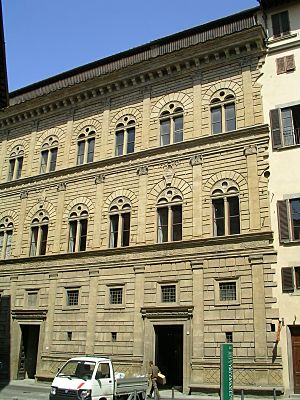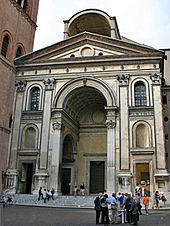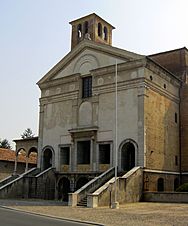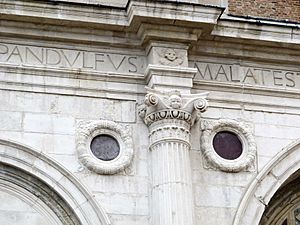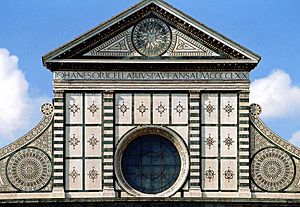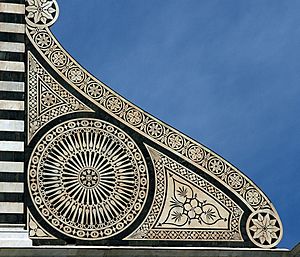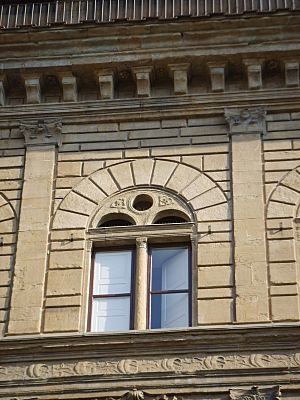Leon Battista Alberti facts for kids
Quick facts for kids
Leon Battista Alberti
|
|
|---|---|
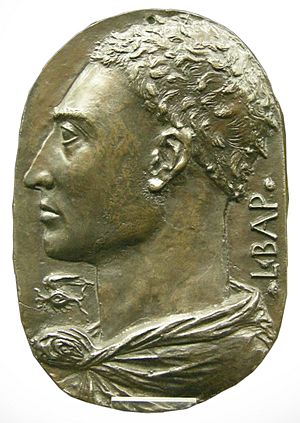
Presumed self-portrait of Leon Battista Alberti
|
|
| Born | 14 February 1404 |
| Died | 25 April 1472 (aged 68) Rome, Papal States
|
| Nationality | Italian |
| Known for | Architecture, linguistics, poetry |
|
Notable work
|
Tempio Malatestiano, Palazzo Rucellai, Santa Maria Novella |
| Movement | Italian Renaissance |
Leon Battista Alberti (born February 14, 1404 – died April 25, 1472) was a very talented Italian person during the Italian Renaissance. He was an author, artist, architect, poet, and even a priest. People often call him a "Renaissance Man" because he was good at so many different things.
While many know him best as an architect, Alberti was also a skilled mathematician. He made important discoveries in this field during the 1400s. Two of his most important buildings are the churches of S. Sebastiano and S. Andrea, both in Mantua, Italy.
Alberti's life story was written down by Giorgio Vasari in his famous book, Lives of the Most Excellent Painters, Sculptors, and Architects.
Contents
About Alberti's Life
His Early Years
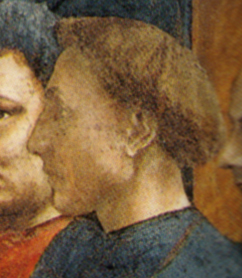
Leon Battista Alberti was born in 1404 in Genoa. We don't know much about his mother. His father was a rich man from Florence who had been sent away from his city. His father was allowed to return to Florence in 1428.
Alberti went to boarding school in Padua and later studied Law in Bologna. He lived in Florence for a while. In 1431, he moved to Rome and became a priest. He worked for the Pope there. During this time, he studied old Roman buildings. This made him very interested in architecture and greatly influenced his own building designs.
Alberti was talented in many ways. He was tall, strong, and a great athlete. He could ride wild horses and jump over a person's head! He was also a gifted writer from a young age. When he was only twenty, he wrote a play that people thought was a real ancient Roman work.
In 1435, he started his first big book, Della pittura (On Painting). He was inspired by the new painting styles in Florence. In this book, he explained how painting works, focusing on perspective, how things are arranged (composition), and colors.
In 1438, he started focusing more on architecture. A ruler named Leonello d'Este from Ferrara encouraged him. Alberti built a small triumphal arch for him. In 1447, he became an advisor on architecture to Pope Nicholas V. He helped with several projects at the Vatican.
Important Building Projects
Alberti's first major building job was in 1446. He designed the front of the Rucellai Palace in Florence. After that, in 1450, Sigismondo Malatesta asked him to change a Gothic church in Rimini into a special memorial chapel, called the Tempio Malatestiano.
In Florence, Alberti designed the upper parts of the front of the Santa Maria Novella church. He famously used two large, decorated scrolls to connect the tall central part of the church to the lower side parts. This was a clever solution that many architects copied for hundreds of years.
In 1452, he finished De re aedificatoria (On the Art of Building). This was an important book about architecture, based on the ideas of Vitruvius and old Roman ruins. The book was not published until 1485. Later, in 1464, he wrote De statua, a less famous book about sculpture. Alberti's only known sculpture is a self-portrait medal.
Alberti was hired to design two churches in Mantua. One was San Sebastiano, which was never fully finished. The other was the Basilica of Sant'Andrea. He finished the design for Sant'Andrea in 1471, a year before he died. This church was completed later and is considered his most important work.
Alberti as an Artist and Thinker
Alberti was different from most artists of his time. He wasn't just a craftsman trained in a workshop. He was a humanist, a scholar who studied ancient Greek and Roman ideas. He was part of a growing group of smart people and artists supported by powerful rulers.
Because Alberti came from a noble family and worked for the Pope, he had a special position. He was a welcome guest at the Este family's court in Ferrara. He also spent time in Urbino with Federico III da Montefeltro, a skilled military leader who spent a lot of money on art. Alberti even planned to dedicate his book on architecture to Federico.
Alberti also wrote other important works. He wrote a book on cryptography (secret codes) called De componendis cifris. He also wrote the first Italian grammar book. He worked with the astronomer Paolo Toscanelli on astronomy and geography. Together, they made a small Latin book about the geography of Rome, called Descriptio urbis Romae. Just before he died, Alberti finished De iciarchia (On Ruling the Household), a book about life in Florence under the Medici family.
Alberti never married because he was a priest. He loved animals and had a pet dog, for whom he even wrote a praise poem! Vasari described him as "an admirable citizen, a man of culture... a friend of talented men, open and courteous with everyone." Alberti died in Rome on April 25, 1472, at age 68.
Alberti's Architectural Designs
Alberti didn't usually get involved in the actual building work. He was more of a designer. He studied the old Roman buildings and understood how columns and beams worked, especially how they looked. He used Classical orders (different styles of columns) correctly in his designs. This was different from his friend Brunelleschi, who used classical elements more freely.
Alberti also thought about how buildings affected the city and its people. For example, at the Rucellai Palace, he added a continuous bench at the bottom for people to sit on. He also believed in planning cities with wide main streets connected to smaller ones, and buildings of similar height.
In Rome, Pope Nicholas V hired him to fix the Roman aqueduct of Acqua Vergine. Alberti designed a simple basin for the water, which was later replaced by the famous Baroque Trevi Fountain.
Some experts believe that Alberti, not Michelozzo, designed the Villa Medici in Fiesole. This villa, built on a hilltop with views of the city, might be the very first example of a Renaissance villa. It fits Alberti's ideas for a country house near a city. This villa then inspired many other buildings in the Florence area from the late 1400s onwards.
Tempio Malatestiano, Rimini
The Tempio Malatestiano in Rimini (started 1447) was a Gothic church that Alberti rebuilt. The front of the church, with its strong shapes, was never fully finished.
Palazzo Rucellai's Front
The design for the front of the Palazzo Rucellai (1446–51) was one of several jobs for the Rucellai family. Alberti added a pattern of flat columns (pilasters) and decorative bands (cornices) in the classical style over the rough stone walls. The inner courtyard has Corinthian columns. This palace set a new standard for using classical elements in city buildings in Florence and greatly influenced later palaces. Bernardo Rossellino carried out the building work.
Santa Maria Novella
At Santa Maria Novella in Florence (1448–70), Alberti designed the upper part of the front. This was a difficult job because the lower part already had three doors and six Gothic niches with tombs. It also used colorful marble, common in Florentine churches. There was also a round window already in place.
Alberti added classical features around the entrance and used the colorful marble across the whole front. He used classical proportions and elements like pilasters, cornices, and a triangular top (pediment). The most famous part of this church's design is how Alberti connected the tall central part to the much lower side parts. He used two large scrolls, which became a common feature on church fronts in later centuries.
Pienza's Town Square
Alberti is thought to have advised on the design of Piazza Pio II in Pienza. This village, originally called Corsignano, was redesigned starting around 1459. It was the birthplace of Aeneas Silvius Piccolomini, who became Pope Pius II. Alberti worked for Pope Pius II. The Pope wanted to use the village as a quiet retreat but needed it to look grand enough for his position.
The main square is shaped like a trapezoid and is surrounded by four buildings. The Pienza Cathedral is the main focus, and passages on either side open up to a view of the countryside. The Pope's main home, Palazzo Piccolomini, is on the west side. It has three floors with flat columns and decorative bands, and two-light windows in each section. This building looks similar to Alberti's Palazzo Rucellai in Florence.
Behind the palace, there's a loggia (an open hallway with arches) on all three floors. It overlooks a beautiful Italian Renaissance garden with amazing views of the distant Val d'Orcia valley and Mount Amiata. Below this garden is a stable for 100 horses. The design completely changed the center of the town. It included a palace for the Pope, a church, a town hall, and a building for the bishops. Pienza is seen as an early example of Renaissance city planning.
Sant' Andrea, Mantua
The Basilica of Sant'Andrea in Mantua was started in 1471, the year before Alberti died. It was finished later and is his most important work. It uses the triumphal arch design both on its front and inside, influencing many later buildings. Alberti saw his role as the architect who created the design. Unlike Brunelleschi, he wasn't interested in the actual construction, leaving that to the builders.
Other Buildings by Alberti
- San Sebastiano, Mantua (started 1458): The unfinished front of this church has led to many discussions about what Alberti intended.
- Sepolcro Rucellai in San Pancrazio (1467)
- The Tribune for Santissima Annunziata, Florence (1470, finished with changes in 1477)
Alberti's Ideas on Painting
Giorgio Vasari, who believed that art reached its peak with Michelangelo, focused more on Alberti's scholarly achievements than his artistic skills. Vasari wrote that Alberti "spent his time finding out about the world and studying the proportions of antiquities; but above all, following his natural genius, he concentrated on writing rather than on applied work."
Leonardo da Vinci, who jokingly called himself "an uneducated person," agreed with Alberti that painting was a science. However, Leonardo was more hands-on and experimental than Alberti, who was more of a theorist. Alberti believed in ideal beauty. Leonardo, on the other hand, filled his notebooks with observations on human body proportions, leading to his famous drawing of the Vitruvian man.
In his book On Painting, Alberti used the phrase "We Painters," but he was more of a hobbyist painter or sculptor. Vasari wrote, "In painting Alberti achieved nothing of any great importance or beauty... The very few paintings of his that are still around are far from perfect, but this is not surprising since he devoted himself more to his studies than to drawing."
Some believe Alberti is shown in Mantegna's famous paintings in the Camera degli Sposi. He is thought to be the older man in dark red clothes, whispering to Ludovico III Gonzaga, the ruler of Mantua. In Alberti's self-portrait medal, he is dressed like a Roman. To the left of his profile is a winged eye. On the back, it asks, Quid tum? (what then?), a question from a poem by Virgil.
Alberti's Important Contributions
Alberti made many important contributions to different areas:
- Alberti created a theory called "historia" (story). In his book De pictura (1435), he explained how people, animals, and buildings in a painting should work together to create harmony. This, he said, would "hold the eye of the learned and unlearned spectator for a long while with a certain sense of pleasure and emotion." De pictura also contained the first scientific study of perspective. An Italian translation of De pictura was published in 1436.
- Alberti used his art books to introduce a new way of thinking about art, based on humanism. He used his connections with artists like Brunelleschi, Donatello, and Ghiberti to create a practical guide for Renaissance artists.
- Alberti wrote an important book on architecture, De re aedificatoria. By the 1500s, it had been translated into Italian, French, Spanish, and English.
- It's hard to know exactly how much Alberti's ideas influenced artists during his lifetime. However, his praise for a painting called Calumny of Apelles led to artists like Botticelli trying to copy it. His ideas about style were put into practice by artists like Mantegna, Piero della Francesca, and Fra Angelico.
- He was so good at writing Latin poems that a comedy he wrote when he was twenty, called Philodoxius, later tricked a scholar who thought it was a real ancient work.
- Some people believe he wrote, or designed the pictures for, the strange fantasy novel Hypnerotomachia Poliphili.
- Besides his books on art, Alberti also wrote: Philodoxus ("Lover of Glory", 1424), De commodis litterarum atque incommodis ("On the Advantages and Disadvantages of Literary Studies", 1429), Intercoenales ("Table Talk", around 1429), Della famiglia ("On the Family", started 1432), Momus (1450), and De Iciarchia ("On the Prince", 1468). These and other works were translated and printed in Venice in 1586.
- According to a short autobiography he wrote around 1438, Alberti claimed he could "stand with his feet together, and spring over a man's head." He also said he "excelled in all bodily exercises; could, with feet tied, leap over a standing man; could in the great cathedral, throw a coin far up to ring against the vault; amused himself by taming wild horses and climbing mountains." It's important to remember that people in the Renaissance often promoted their own skills, so we should read these claims with that in mind.
- Alberti also claimed to be a skilled musician and organ player, but there isn't strong proof for this. He was a canon (a type of priest) in the main church of Florence, which might have given him free time for art, but this is just a guess.
- He was interested in drawing maps and worked with the astronomer and mapmaker Paolo Toscanelli.
- In terms of beauty in art, Alberti was one of the first to say that art should copy nature, but only by choosing its most beautiful parts. He said, "So let's take from nature what we are going to paint, and from nature we choose the most beautiful and worthy things."
Alberti's Published Works
- Momus, Latin text and English translation, 2003 ISBN: 0-674-00754-9
- De re aedificatoria (1452, Ten Books on Architecture). Alberti, Leon Battista. De re aedificatoria. On the art of building in ten books. (translated by Joseph Rykwert, Robert Tavernor and Neil Leach). Cambridge, Mass.: MIT Press, 1988. ISBN: 0-262-51060-X. ISBN: 978-0-262-51060-8. Latin, French and Italian editions and in English translation.
- De Cifris A Treatise on Ciphers (1467), translated by A. Zaccagnini. Foreword by David Kahn, Galimberti, Torino 1997.
- "Leon Battista Alberti. On Painting. A New Translation an Critical Edition", Edited and Translated by Rocco Sinisgalli, Cambridge University Press, New York, May 2011, ISBN: 978-1-107-00062-9
- I libri della famiglia, Italian edition
- "Dinner pieces". A Translation of the Intercenales by David Marsh. Center for Medieval and Early Renaissance Studies, State University of New York, Binghamton 1987.
- "Descriptio urbis Romae. Leon Battista Alberti's Delineation of the city of Rome". Peter Hicks, Arizona Board of Regents for Arizona State university 2007.
Alberti's Lasting Influence
Historian Franco Borsi says that Alberti's writings on architecture still influence modern buildings today. He notes that ideas like Frank Lloyd Wright's focus on nature, Mies van der Rohe's clean classical style, Le Corbusier's rules and human-based systems, and Louis Kahn's return to "antique" forms all show Alberti's influence on modern architecture.
See also
 In Spanish: Leon Battista Alberti para niños
In Spanish: Leon Battista Alberti para niños


